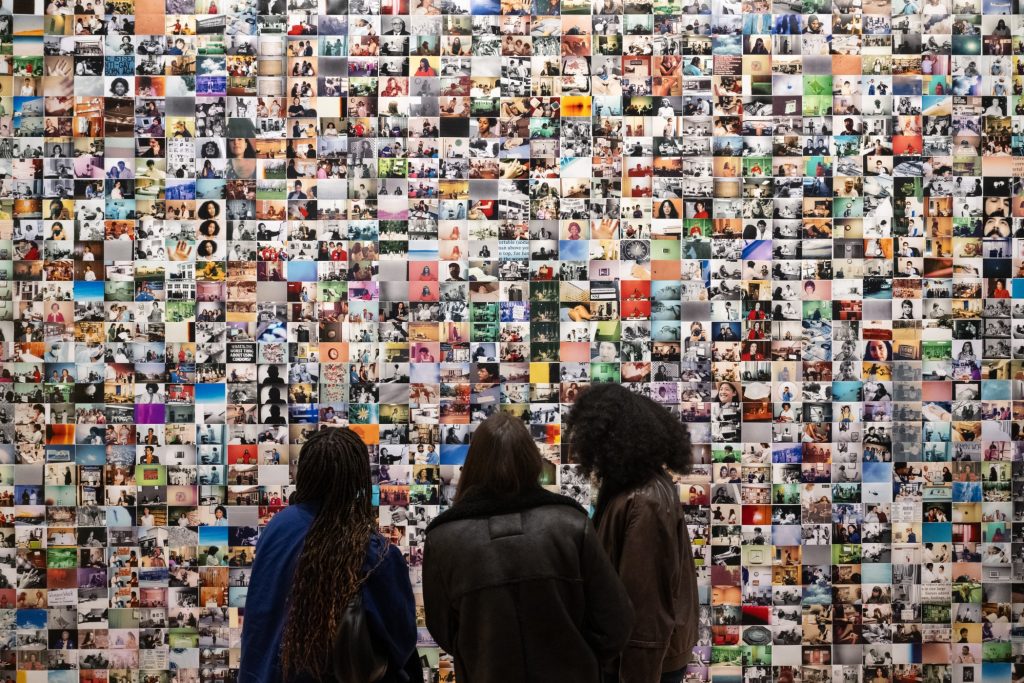It was consistent across this year’s Whitney Biennial that I was seeing things I never saw before, which is always a bonus in my experience. With artwork “The Last Safe Abortion” (2023) by Carmen Winant, the tone turned especially serious — and, critically, human.
The artwork had an earlier iteration at the Minneapolis Institute of Art in 2023 before showing up this year as part of the Whitney Museum of American Art’s regularly held survey of contemporary art.
The Artwork’s Composition
It is comprised of thousands of printed photographs arranged, with an eye towards aesthetic and thematic flow, to fill the wall. In terms of scope and concurrent effect, it’s like “Vir Heroicus Sublimis” (1950-51) by Barnett Newman. You stand before the finished creation, and even if briefly, you end up swept up into the artwork’s world. The commanding fullness in your perceptual space of something this big keeps your attention focused.
As the name of Winant’s artwork indicates, the actual photographs depict work involved in the providing of abortion care. The expansive installation seems to focus on office work and related endeavors, like outreach: the wide-ranging, rigorous labor in between medical personnel providing actual abortions.
The pictures are, in significant part, from archives held at abortion clinics, the custodians of which joined with Winant in moving this work further along. In an interview published at Aperture (a photography foundation), she talks about wanting to prioritize — in serious terms — agency for the people connected to these images. According to Winant in that same interview, clinics represented by her collection of images hail from Nebraska, Ohio, Iowa, Illinois, Minnesota, Georgia, Texas, Kansas, New York, and North Dakota.
An informational card from the museum posted by the actual artwork added that no actual patients were depicted in any of the photographs. But what is there is persistence in the everyday tasks of running the kind of facility that Winant is elevating with this entire undertaking — combined with outright activism.
I sometimes lean towards thinking — at least at first — about an artwork without too much reference to external forces or trends, instead hoping to just get something out of what is right in front of me.
And while from a technical standpoint, Winant’s undertaking is certainly impressive, the entire endeavor is about spotlighting these real-world experiences snowballing into the present day’s renewed and shifting (depending on the latest legislative status quo) uncertainty around obtaining reproductive health care — what for decades was legally protected at a base level, undone with the reversal of Roe v. Wade.
Correcting the Record with Real, Personal Stories
From an outreach and activism standpoint, Winant’s artwork is an impactful step towards filling what, for some, might have been a serious gap in their (visual, but also general) understanding. How many people have actually seen images like these, not to mention this many at once, documenting the day-to-day work of running a clinic that meets often vulnerable individuals in their times of personal need?
“The Last Safe Abortion” is a proactive undercut to the controlled, cultivated flow of a very specific set of visual information. Specifically, as was already noted elsewhere, anti-abortion activists often utilize graphic, gory imagery in their outrage over these processes. Here, the people involved in these situations of providing abortion care can take center stage. As much as a photograph or image collection can allow, they can speak for themselves. They’re here, front and center.
Just as a general matter, as someone who is very involved politically, I feel that Winant’s artwork keys into a very important need for the individuals actually targeted by policy decisions like restrictions on abortion to be given real input.
On another front, the images that Winant includes in “The Last Safe Abortion” often depict quite small groups of people at a time, so that, when you’re looking at these displayed images up close, you feel like you’re really getting a snapshot of these people on an individualized level — which is another powerful component of the artwork.
Abortions aren’t conducted for aliens from outer space. Abortions and related forms of reproductive health care are undertaken to benefit real-world, everyday people. The kind of person with whom you might exchange pleasantries at the grocery store, develop a friendship with at your job, or see dropping their children off at school. They’re someone who cooks, cleans, and works for a living. This isn’t some extraterrestrial concept. Time and again, over and over, it’s someone with whom you might meaningfully connect in any of a whole host of situations. Your neighbor — or family. A tired stranger walking by. The point is: it’s anyone.
And the same goes for the people who work so persistently in these clinics, whether before Roe v. Wade was ever decided, in the decades of its continuance during which political forces still tried to claw back access to reproductive care, or now, when access to these sometimes life-saving procedures changes from state to state. These are just people trying to help other individual people in their time of need.
And that thread shines in the imagery that Winant assembled.
The 2024 Whitney Biennial’s end date was August 11, but some of the artwork is remaining on view through late September on the museum’s sixth floor. And that selection includes this piece!

Featured image: same as above
You may also like
-
Diana Kurz at Lincoln Glenn in New York: A Review of a Shining Art Exhibition
-
Dustin Hodges at 15 Orient in New York City: An Ensnaring Exhibition at an Exciting Gallery
-
Maren Hassinger at Susan Inglett Gallery in New York: Reviewing an Uplifting Art Exhibition
-
Enzo Shalom at Bortolami in New York City: Reviewing an Entrancing Exhibition of Paintings
-
“Ben Werther: Townworld” at Amanita in New York City: Reviewing a Richly Memorable Art Exhibition